by chris ayres | Sep 2019 | UK to New Zealand
The next hop was 50 miles to Dillon bay on Erromango island. I wasn’t sure whether I would be able to do this in daylight hours, there is just 12 hours of daylight here. I weighed anchor just before sunrise and had a nice view of Mt Yasur the volcano “pothering” out its smoke.

Mt Yasur, Tana
The forecast had been for 10-15 knots from SE but it was stronger than that so I was able to keep up a good speed and 11 hours later I had dropped anchor in Dillon Bay. I was very pleased with that.
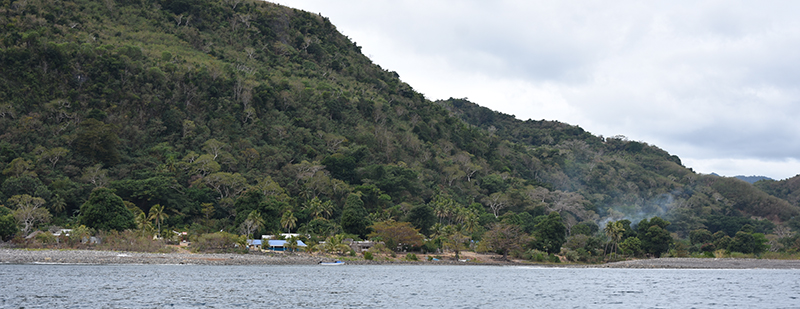
Dillon bay
David from the village paddled out in his outrigger dugout canoe with a gift of bananas, pawpaw and the biggest lemon I had ever seen. I gave him some flour and rice, the supply boat only visits once a month so they run low of things at times
He has built a “yacht cub” ashore for visiting cruisers. Next day I visited him there, he has set himself up as a guide. He showed me the village, the gardens and a delightful swimming pool in the river where I had a lovely dip. He told me the names of the trees and their uses some as a source of incense (sandlewood) others to use as lamps, and which trees they made their dug out canoes from. I was surprised to learn that there are Kauri trees here and they have created a protected zone for them. Afterwards I had lunch with them, rice , yams, fried bananas, manioc, a stew/soup of beef and cabbage fresh squeezed lemon juice and of course pawpaw. Again I learned a little more off the island. Although it is quite a big island there are just 2 villages and there is virtually no development on the island and it is largely off the tourist track.
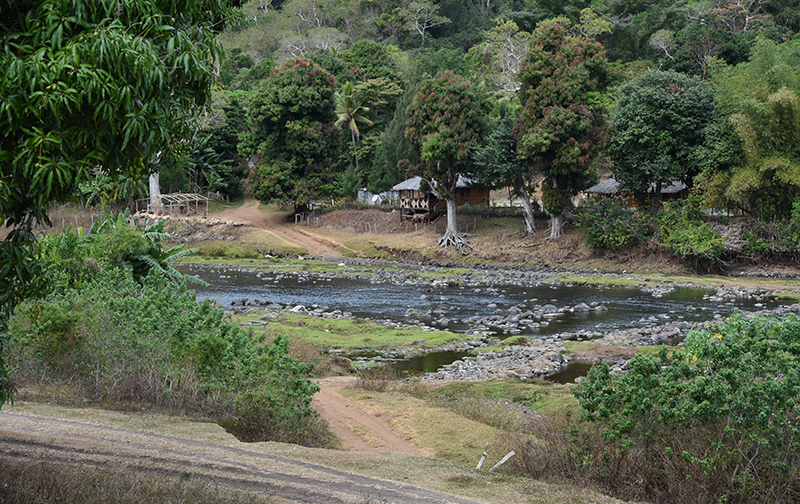
the River at Dillon bay
Some strong winds arrived so I stayed put for a couple of days as the forecasts were for 20-25 knots and very rough seas and I didn’t fancy getting beat about.

Supply ship at the beach
It was 80 miles to Efate, the next island and the capital Port Villa, so it was to be a night time passage. Setting off late afternoon once the weather had eased I was hoping for a quiet and peaceful passage, trouble was the wind had eased so much there was virtually none. I had to resort to motoring, at least the seas were calm, shame about 12 hours of engine noise though. Still arrived in Port Villa and was soon secured to a substantial mooring ball.
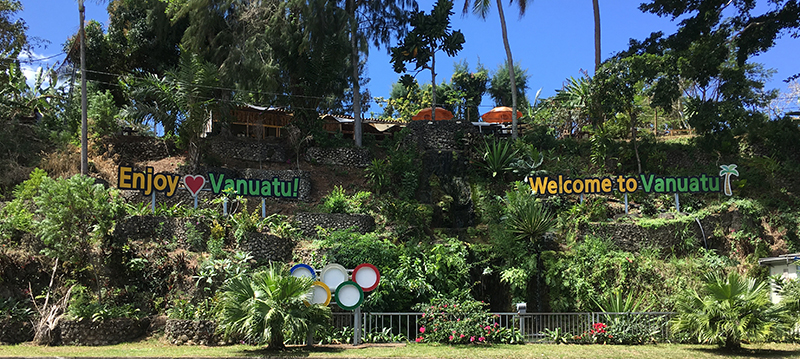
Port Villa welcome
Ashore it was a bit of a culture shock, shops, banks, restaurants, busy with traffic, all the trappings of a tourist town and the place seemed overrun with Aussies. Well I suppose it’s just a fairly short hop for them, a bit like Brits jetting off to Spain or Greece for their holidays. Still it was good to replenish the stores on things that I had run out of or was running short off. There was a strong French influence about the place, some french supermarkets and the bread was baguette style.

Distant view of mooring field Port Villa
With such a sheltered & calm mooring field here I thought it ideal to clean off the bottom of Sea Bear after all she had been in the water for 6 months now. I was lying in the dinghy, arm in the water scrubbing the waterline when the moorings boatman spotted me and made me an offer I couldn’t refuse to clean the hull for me for a very cheap price. So now we have a nice clean hull again, it makes quite a difference to the sailing performance.
by chris ayres | Sep 2019 | UK to New Zealand
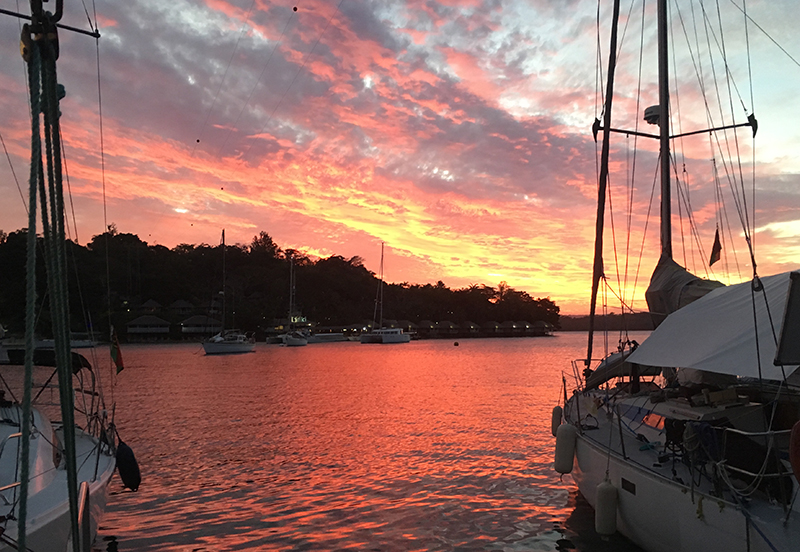
Port Villa sunset
I ended up staying longer than intended in Port Villa. Jan & Richard were on their way back from Santo here so I waited an extra couple of days to see them again. Then the weather turned bad and it rained just about non-stop for 3 days. When eventually the rain stopped it was very windy with a strong wind warning out and very rough seas and big waves. So although this was frustrating as I wanted to be on my way, it was better to be here tied to a big strong mooring in a sheltered place than out at anchor somewhere. I could pass the time wandering through the town.
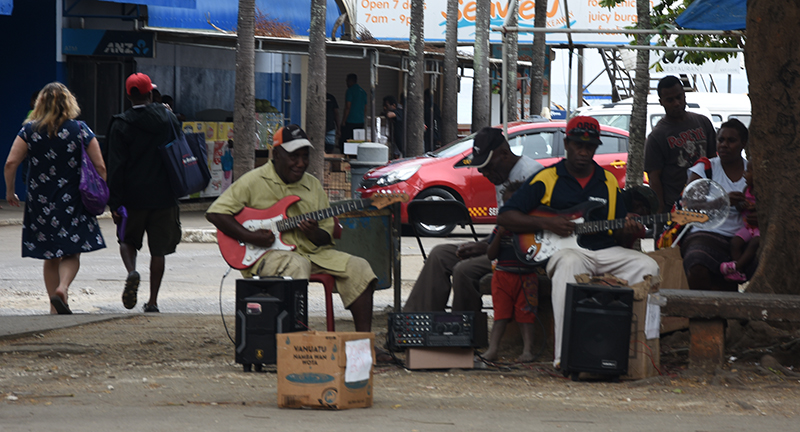
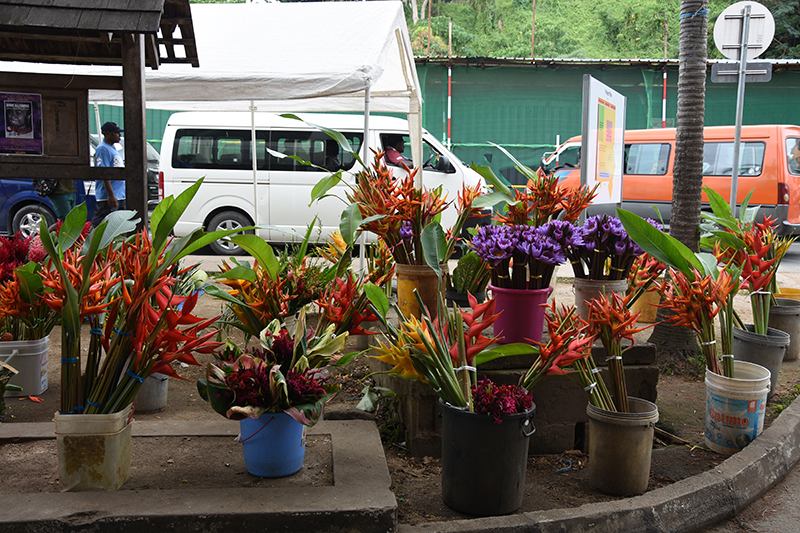

One day it dawned fair and although it was still quite windy the strong wind warning had gone. I had originally meant to hop up to Havanna harbour in the north of the island but a rhinoceros beetle scare was on and the whole area had been declared a no go zone.
In this case it was about 80 miles up to Epi, so another night passage was on the cards. I left the mooring in the late afternoon, giving myself a few daylight hours to clear out of Mele bay and get around Devils point which has a reputation for rough seas.

Leaving Port Villa
It was still windy with the wind at the top end of the forecast level of 15 -20 knots and the seas fairly rough and rolly. I settled for a triple reefed main and the staysail and was still making 5 knots.
It turned out to be a long sleepless night largely on account of other traffic. Just before dusk a yacht past going south. Later the first boat approaching from my stern I was able to resolve as would pass my stern and pass on my port side some way off.
The second set of light seemed to be going not that much faster than me and was always seemed to be in the same place astern. Boats around here don’t seem to have AIS, that most valuable tool I couldn’t relax. Hours later it was much closer, its navigation lights hidden by the blaze of 2 great spotlights and it seemed to be heading straight for me. I took the unusual step for me of trying to call them up on channel 16 vhf but could get no response. Maybe they had heard me though as they seemed to change course slightly went past my stern and passed me on my port side. I was quite relieved. I was kept on my toes by more lights ahead, another boat this time going south and passed some way off and I spotted a yachts tricolour some way off. seemed a busy old night so I prudently decided to forgo my usual naps at night.
Dawn revealed Epi ahead and the Shepherd islands way off to the east. One had the perfect volcano cone profile and I wished I was passing it closer. Off the SE corner of Epi there are some submarine volcanoes, quite active apparently, probably not wise to go that way!
The seas were calmer once in the lee of the island and before too long I was lining up the boat to go into Revolieu bay to drop the hook and catch up on a little sleep after a passage of 87 miles and 18 hours.
by chris ayres | Sep 2019 | UK to New Zealand

After a day to rest and relax at Revolieu I set off for Lamen Bay just 13 miles up the coast. There was a strong wind warning out but reasoned in the lee of the island things would be manageable. As often in the lee the winds were very variable and gusty and it seemed to take forever to round Cape Foreland, perhaps the current was against me. As I neared Lamen Bay the wind really piped up and I had a head wind of about 25 knots. There were about 7 boats anchored here but fortunately anchoring went well, it can be tricky in very strong winds and I dropped the hook in 9m and the holding was good in white sand.
Next day the forecast was not looking good 30 knot winds were predicted for the next few days so I moved a little closer inshore to anchor in 6m, reasoning it would be a trifle more sheltered. Shane & Hannah in a NZ cat “Beachlands” offered & helped me in this as sometime is strong winds it is difficult to maintain control raising the anchor whilst single handed.
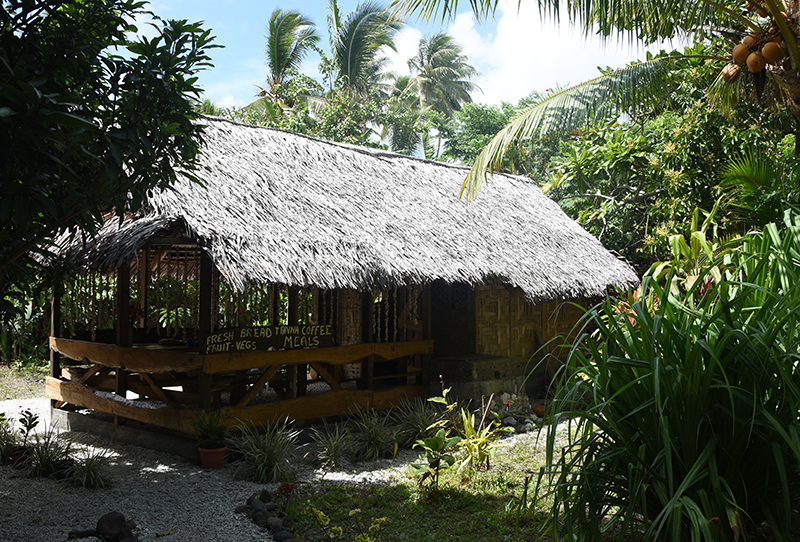
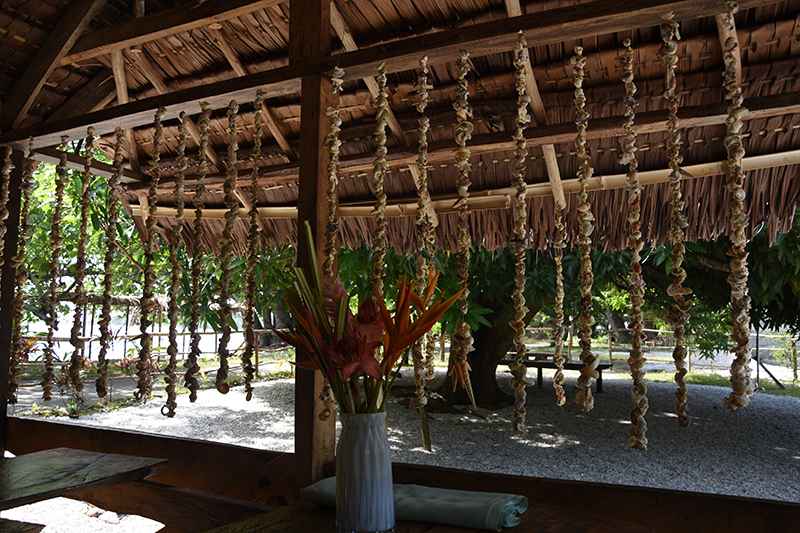
“Beachlands” took me ashore for coffee at a lovely little spot next morning as I hadn’t yet inflated my dinghy with the winds so strong but I did later and I took a walk along the beach past the village and airstrip and through the conservation zone right up to the NW point of the island. Apparently turtles lay eggs on the beaches in the conservation zone. I had seen lots of turtles swimming about in the bay, but unfortunately didn’t spot any dugongs for which the bay is famous.
One evening I was invited for dinner aboard “Beachlands” with Shane, Hannah & Allanha. Had a nice curry and drinks, a very convivial eve.
We also had a meal at “Benintoes”, the wife of the chief at her lovely little restaurant all decorated with strings of sea shells. We had previously spent some time collecting shells on the beach with her to add to her strings.
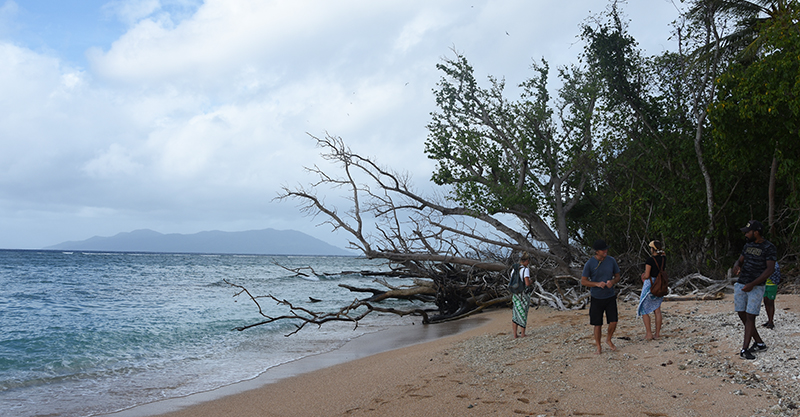
Sea shell collecting
After some day the winds eased and all the boats bar me and the French couple I had first met in Anatom, cleared out. I though I would wait a day to give the seas, which had been forecast for 3m swells, more chance to calm down.

I went for a longish walk inland past another village up a very steep hill and then a little south, nice views in parts and very interesting. I planned to leave the next day after picking up some bread that eve baked by Beni for me.
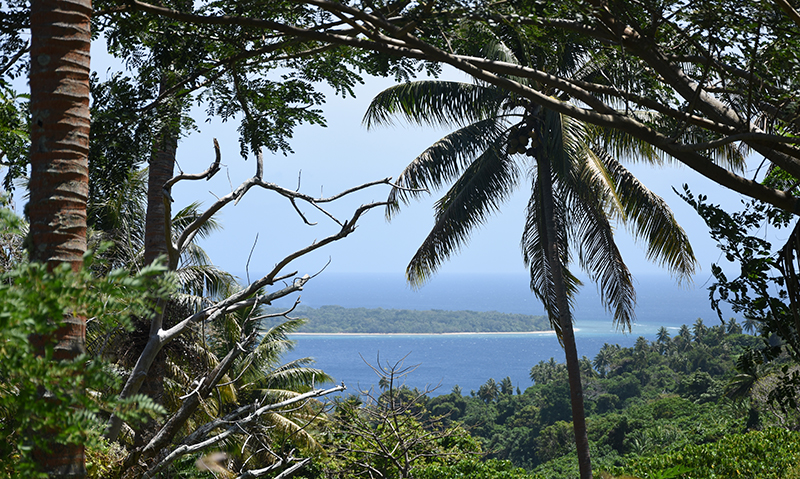
Lamen island from above Lamen bay
by chris ayres | Oct 2019 | UK to New Zealand
I weighed anchor and left Lamen Bay at first light, at first there was no wind but it soon kicked in. I settled on a double reefed main and yankee setting course one through between Lamen Island and the NW tip of Epi for Sangorpitu point on Ambrym. There was some good scenery, to the East was the perfect conical active volcano of Lopevi with a little closer the island of Paama.

Lopevi
Away to the west was the island of Malakula and ahead to the North Ambrym itself with the twin volcanoes of Benbow and Marum.

Benbow & Marum volcanoes, Ambrym
With a good wind I soon made the 27 miles to Craig Cove, but although I ventured into the bay as far as the anchorage I didn’t stop. To my mind it was not sheltered enough , its a deep anchorage too so getting a suitable depth to anchor looked too close to the shore and besides it is said the holding is not good. Since it was still before midday I carried on, rounding Dip point to the lee of the island. I did investigate the anchorage at Baoumi point but there was a little bit of swell here and again it didn’t feel sheltered enough. Carrying on soon the wind increased and I had 30 knots close hauled. I eventually anchored off the black sand beach at Ranvetlan in 7 m. This felt right, more sheltered although the wind was still very strong with williwaws, causing the boat to sheer about quite wildly at times. Miles run 45 in 9hrs 45 mins. I had seen only 1 yacht all day, that anchored in deep water just past Baoumi point.
The wind remained strong with a strong wind warning for the next two days. A NZ boat arrived next afternoon and they later reported that they had had 37 knots of wind. I stayed aboard all day.
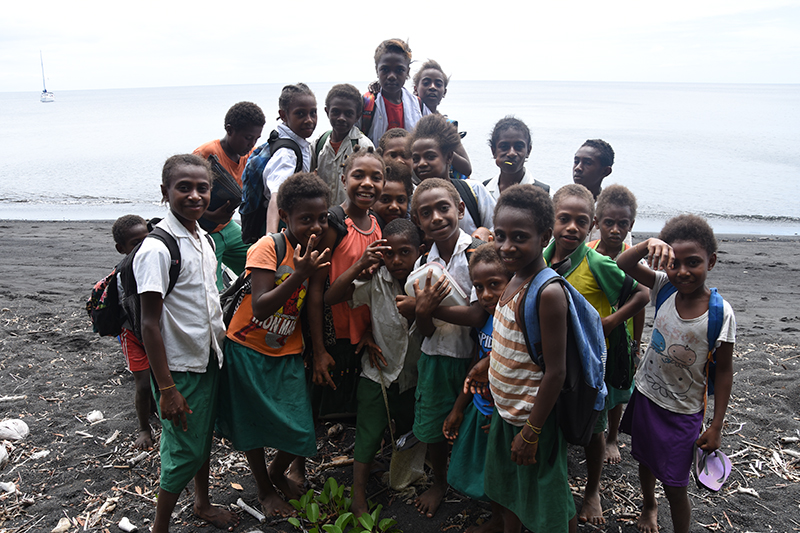
On the beach, Ranvetlam
Next day although still windy it wasn’t so bad so I ventured ashore. I met a group of school kids walking back along the beach to their village from school. I walked along the beach and then the track to the village of Ranon. I was greeted by a boy sitting under a huge mango tree who handed me a mango to eat, delicious it was too. The older boys came past fresh out of school and chatted with me. Almost all of them carrying machetes and catapults. The machetes or knives because they are such an essential tool of life here, for clearing tracks through the woods, harvesting fruits and yams, breadfruit and such, the catapults for shooting down mangoes from the trees. Most people, even women & quite young children here always carry a machete or knife all the time
I thought of the situation in England where they wouldn’t be allowed anywhere near school let alone out on the street carrying knives. But there is no violence or stabbings here and it made me think that it is our politicans and police that have it wrong. It is not the carrying of knives that is wrong or the problem, it is the hatred in peoples hearts that begets the violence.
I had a walk through the village and ate a plate of rice and meat at a sort of fundraiser. Saw some wood and stone carvings.

Samuel & his carvings
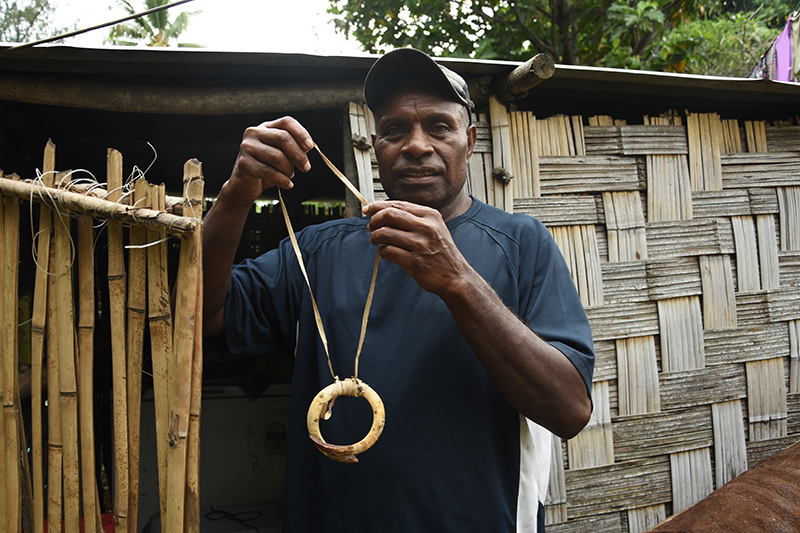
Boars tusk pendant
Another day I walked along the coast past what I took to be the the ruins of a copra plant to the other village Ranveltan, returning a little way inland by the track.

Unloading stores at Ranon
Leaving here I sailed back to Baoumi point to investigate the hot springs there. However with it being so far into the dry season, they were dried up. There was just a slight sulphurous smelling pool of still water behind the black sand beach. I pressed on inland up the course of the river but it was dried up too.
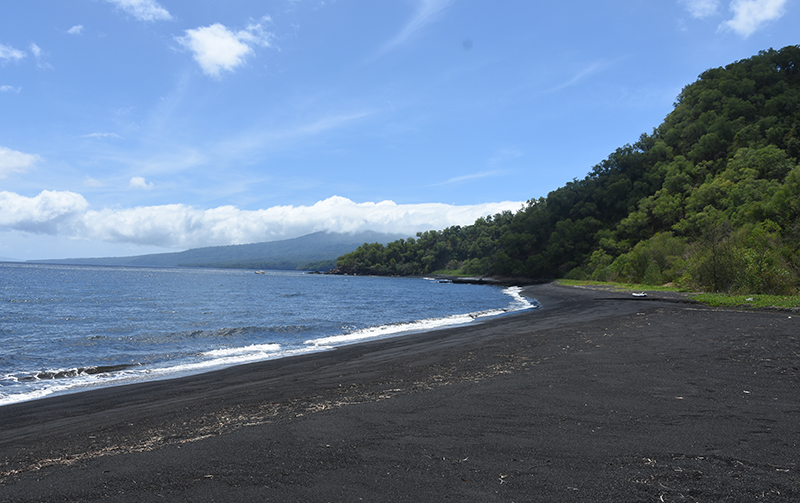
Beach at Baouma Point
Returning to the beach a bit of a swell had started so it was time to clear out quickly. Back past Ranon I anchored at Nupol.
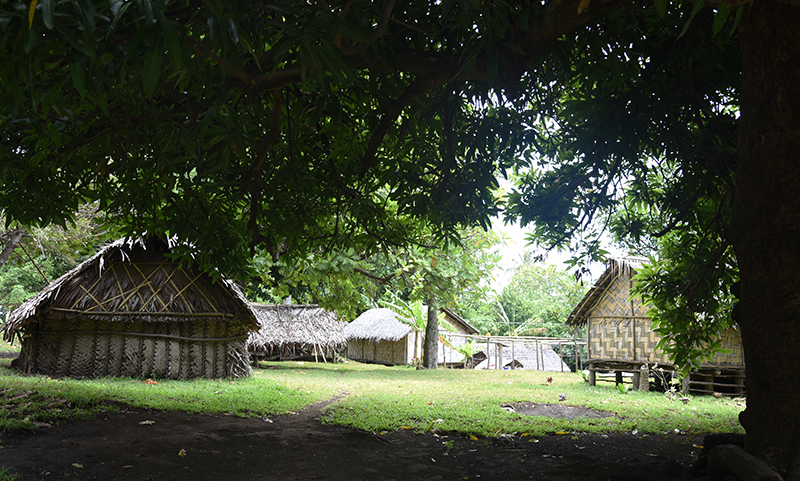
Nopul village
Ashore next day I walked along the track past the village of Magham to Olal. Here I was lucky as they were sacking up the copra, carrying it down the beach to a lighter to tack out to a freighter anchored offshore outside the reef.
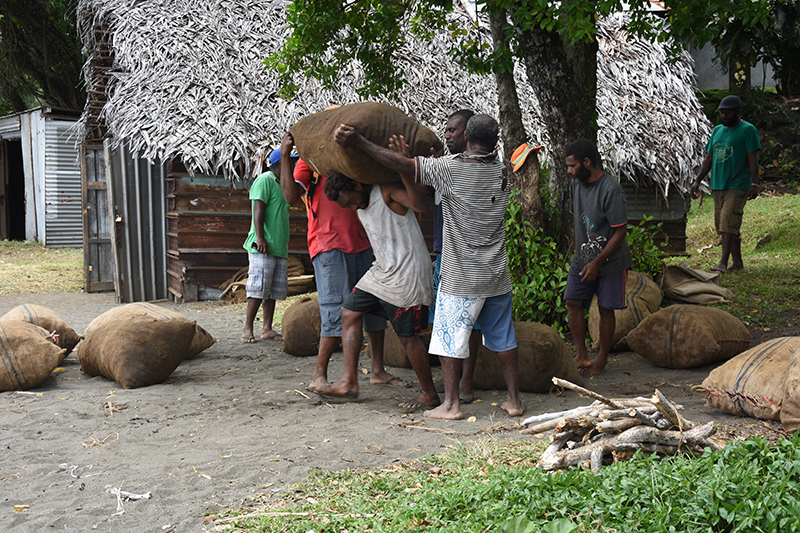
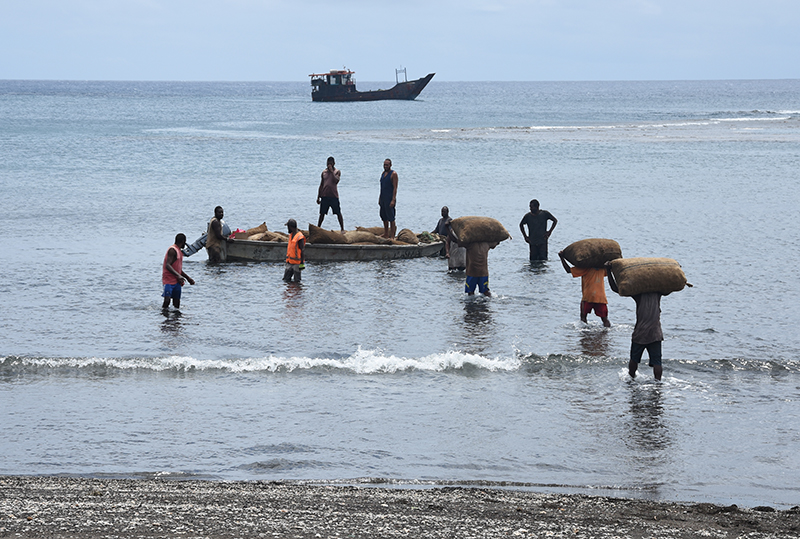
I was a given a new fruit for me a Ningauvung or Rose Apple- a bit like a pear in texture. Here by the stamped earth ground of what looked liked a meeting place by the kava shack were some of the wooden carvings that are distinctive off the island. Ambrym is a centre of magic in Vanuatu and home to the Rom dance. Unfortunately it is the wrong time of year for me to see any.

Carvings at Olal
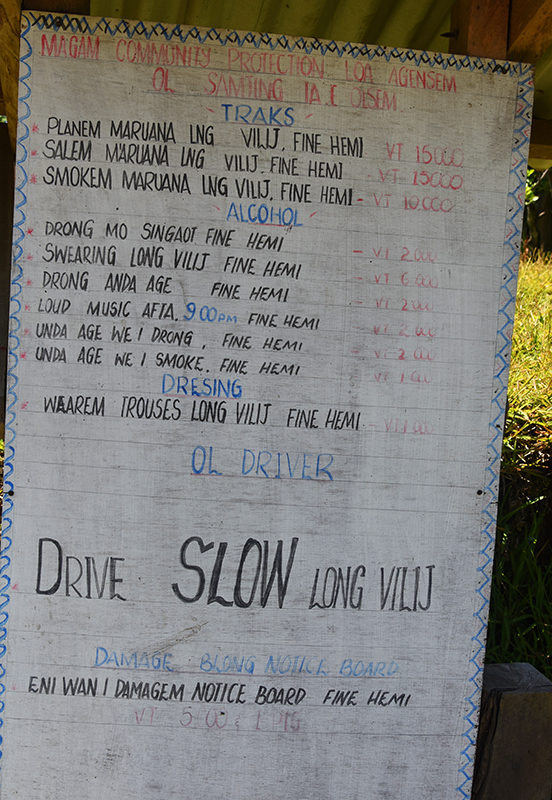
Magam notice board – can you translate the Bislama?
Another walk took me along the coast and then inland into the hills. I was hoping to get to the village of Fanla, a kastum village but I took a wrong turning. Back on the main track I met a man just returning from his garden in the forest carrying what turned out to be nuts in his turned up t-shirt. He said if I had time he would take me to his house and crack some for me. We walked into the village and outside his hut he had a special stone with a depression in, the nut was stood up on end and crack with a hammer. Tasty they were. His brothers all came around to say hello. When I left he gave me 2 fresh bread rolls still warm from the oven and a pawpaw.
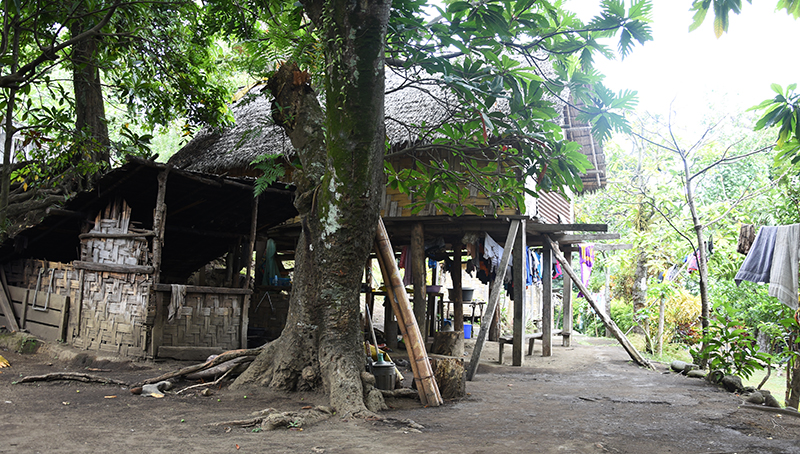
House in village
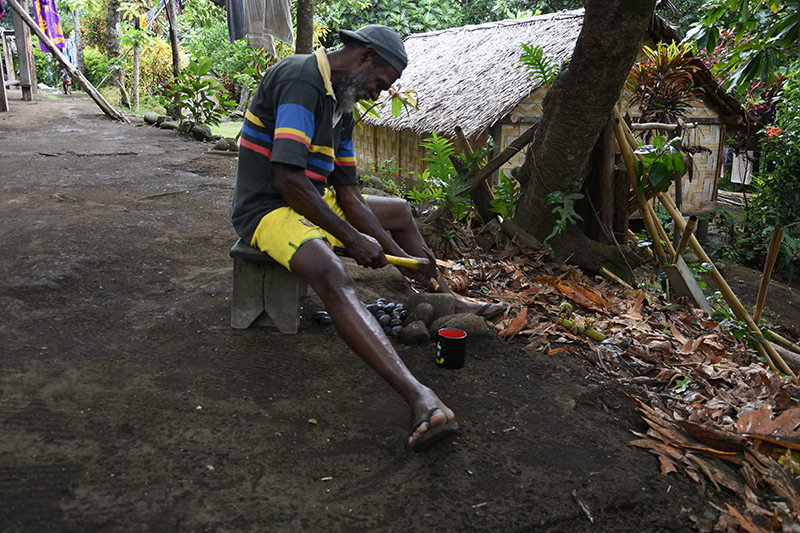
Cracking nuts
I am just continually knocked out by the friendlyness of the NiVans. They have so little but are so generous
by chris ayres | Oct 2019 | UK to New Zealand
My last few days on Ambrym were bedevilled with rain and strong winds and i didn’t achieve much. With the wet weather I gave up on trying to get to Fanla and thought it time to move on to the next island in the chain, Pentecost. At last wind wise we had a reasonable forecast, that is not too strong although showers were promised for the afternoon. It being about 12 miles across to Pentecost I could do that in a morning and hopefully be safely at anchor before rain. It was not to be. It was drizzling lightly when I weighed anchor in the morning, little wind at first but it soon picked up and I set a double reefed main and the yankee. With a strongish wind on her stern quarter, this is a combination that Sea Bear seems to like and she was going well. Unfortunately the wind speed indicator instrument had stopped working, the sensor cups at the mast head were not rotating at all. A bit of a blow this.
I passed a large school of what I thought must be pilot whales, adults and young. They were too large for dolphins and had a more leisurely motion, a pleasure to see.
A few miles short of Homo bay it came on to rain very heavily and the wind died too. visibility was appalling. Fortunately the approach to anchor in Homo bay is very straightforward with no offshore dangers. Just a matter of heading for the beach until you reach a suitable depth to anchor. I dropped the hook in 10 m about 100 m from the beach, the rain continuing to pour down. The rain didn’t deter two locals from the village paddling out in their dugout canoes to see me. Later in the afternoon it stopped raining and they returned with fresh prawns, grapefruit, bananas, & water cress for me to buy.
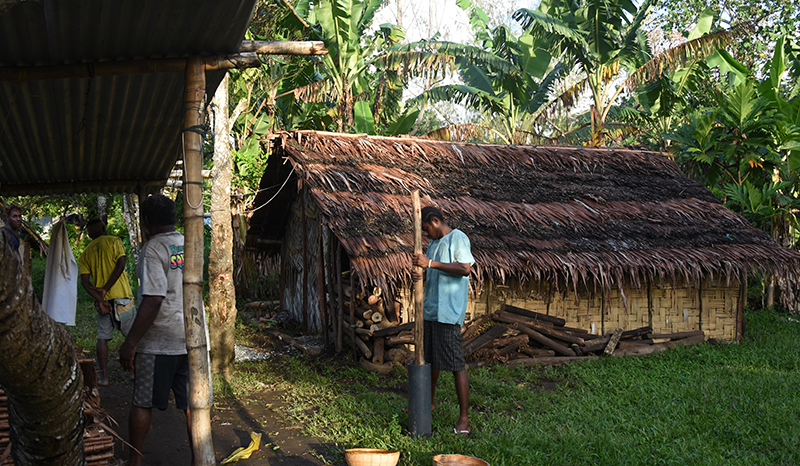
Pounding Kava
I went ashore and watched them prepare Kava and had a couple of glasses with them before returning to the boat to cook the fresh prawns for my dinner. Delicious cooked with garlic and ginger on a bed of rice.
Next day I went ashore and took a walk with chief Sam to a huge Banyan tree and then dug up some water Taro.

Harvesting Taro
Back at his hut he prepared what he called laplap. Basically boiled Taro and Yam then mashed with a little fresh coconut milk and rolled out on a special slab of wood and more coconut milk puddled over the top. It was OK but hardly a gastronomic wonder.
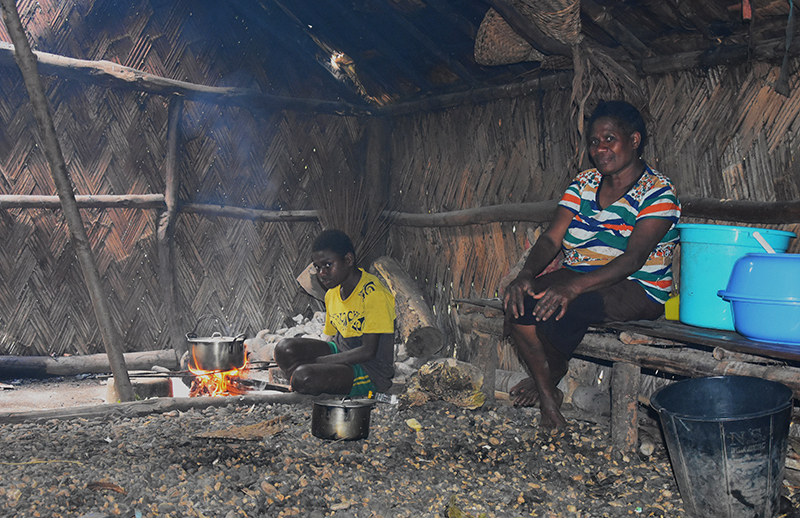
Cooking taro
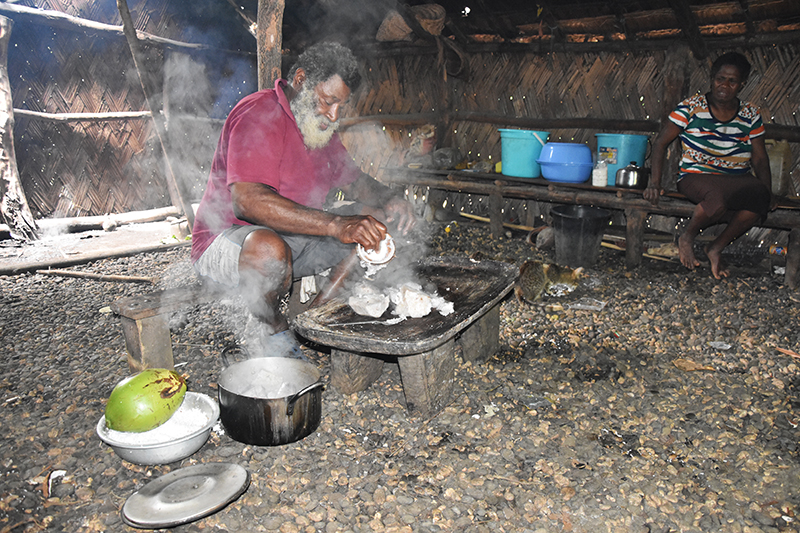
Mashing Taro & Yam
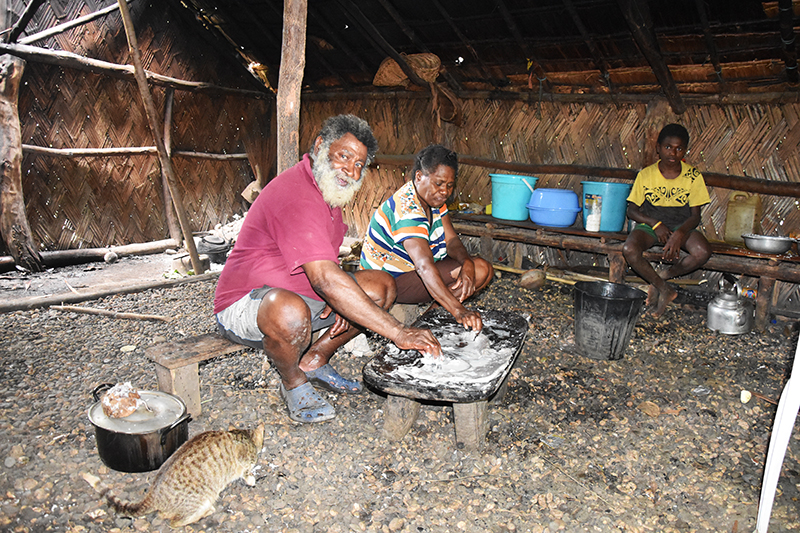
Eating laplap
In the afternoon I walked along the beach and track as far as Cook’s rock (yes that man again).
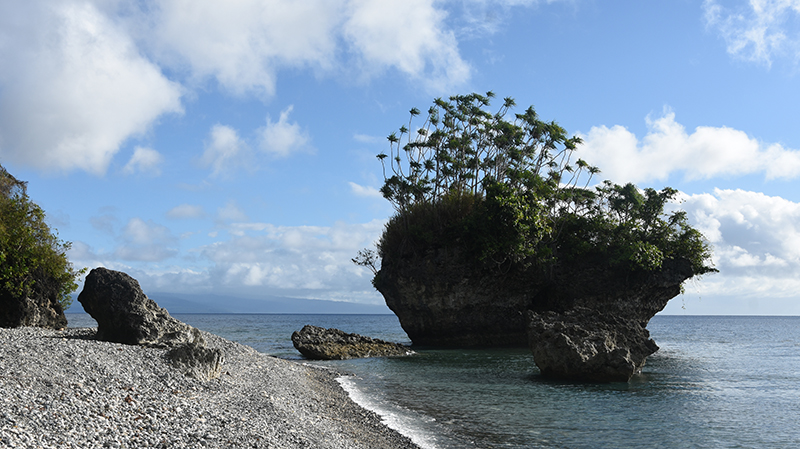
Cook’s rock
I moved anchorage to the next bay, Wali bay. Pentecost is home to land diving, Bungi jumping is derived from it. I had hoped to see one of the land diving towers here but it had fallen down. They are temporary structure from trees & branches bound together with vines. They only land dive in April & May when the vines they use for “bungies” are green and pliable enough. However they was apparently still a tower standing at the next village Rangusuksu so I walked along the coast to see it.
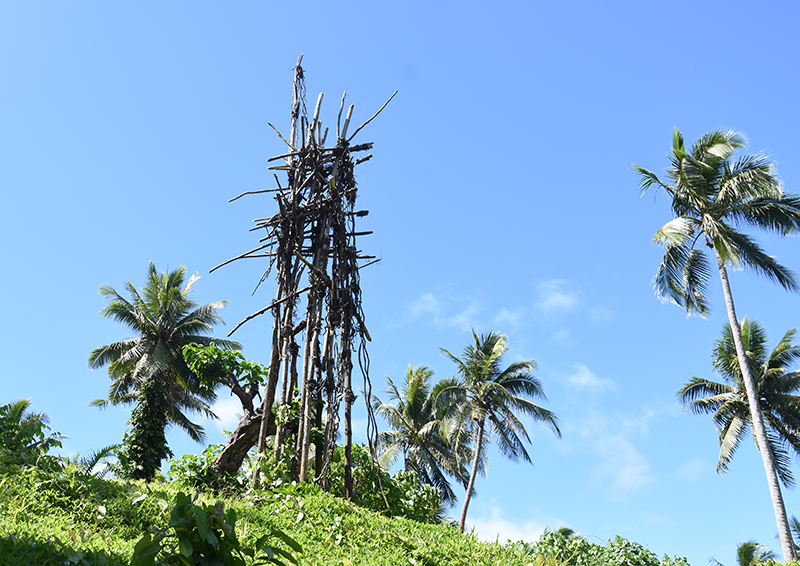
Land diving tower
Back at the boat I moved further north up the coast, anchoring in Waterfall bay. After asking permission at the village I walked up to the waterfall. The plunge pool was a bit difficult of access and not so good for a bathe but to stand in the cool spray was very refreshing and I did bathe in a pool just a little way downstream.
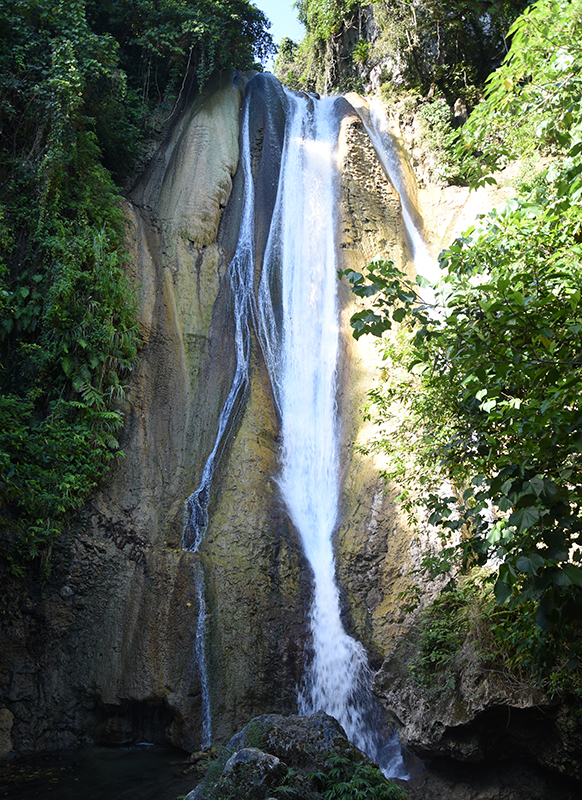
Waterfall
Moving on next day I sailed up the coast and entered Loltong bay. The entry was between two shallow reefs which supposedly dry, there are leading marks to help you in but they are difficult to pick out and see until you are reasonably close in. It was one of those heart in mouth approaches taking it slow and steady. inside I anchored in 5m on sand. The holding is good but you do feel a bit surrounded by reefs.
I saw turtles here and also what I thought was probably a dugong.

Lontong village
I had a walk ashore through the village next day, visited a cave and a fresh water spring on the beach, the water just bubbling up through the sand and pebbles.
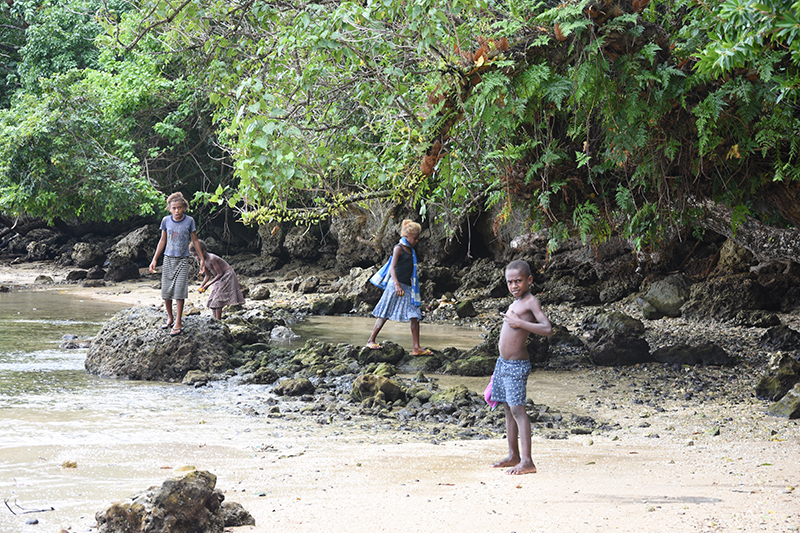
Fresh water spring on beach
It rained hard in the afternoon with very poor visibility, that laid to rest any half formed plans of moving on in the afternoon.
by chris ayres | Oct 2019 | UK to New Zealand

Ambae from Loltong bay
Morning dawned, although overcast it looked suitable for moving on so I weighed anchor and motored carefully out between the shallow patches. Once clear I hoisted sail and set course for Maewo the next island to the north about 10 miles away. The forecast was for an E wind 10-15 knots but oh how wrong this was. It wasn’t long before the weather closed in and I was hit with a vicious rain squall 25 knots plus of wind, torrential rain and almost no visibility. Fortunately I had clear water all around. The squall eased after a while but then I was hit by an even fiercer one perhaps 30 -35 knots. I was down to just a triple reefed main at this point but the seas were building with breaking crests, it was far from pleasant.
Eventually it passed and the weather looked to be improving. I passed two yachts exiting Asanvani bay my next objective. Entry to this was fairly straightforward as long as good offing was given to Teterigi point and its off lying rocks.

A fairly deep anchorage this I dropped the hook in 14m in sand and rocks. In consequence the anchor chain spent my stay here grumbling over the rocks as the boat swung to the tide and breeze. Nevertheless it was a pretty spot with sea caves, a waterfall that tumbled almost into the sea and a white coral sand beach. I explored the sea caves by dinghy but they were dissappointly shallow, but nearby there were some nice corals amongst the rocks and some brightly coloured fish.
I visited the waterfall and had a long chat with the owner of the little bar at it’s foot. It was closed at present but he told me of the place and off the dramatic views from here when Ambae erupted in 2018 and off all the ash that it deposited.
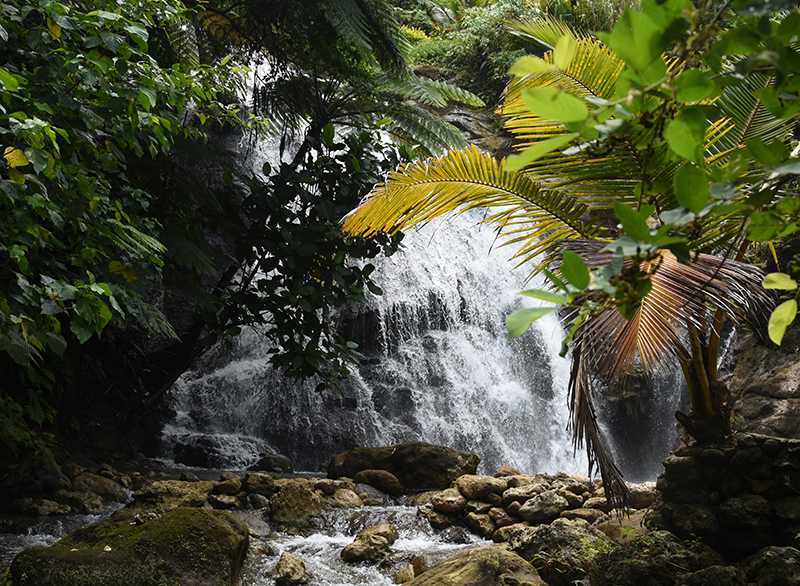
Waterfall Asanvari bay
I walked through the village and to the other side of the point for a fine view back to Pentecost.
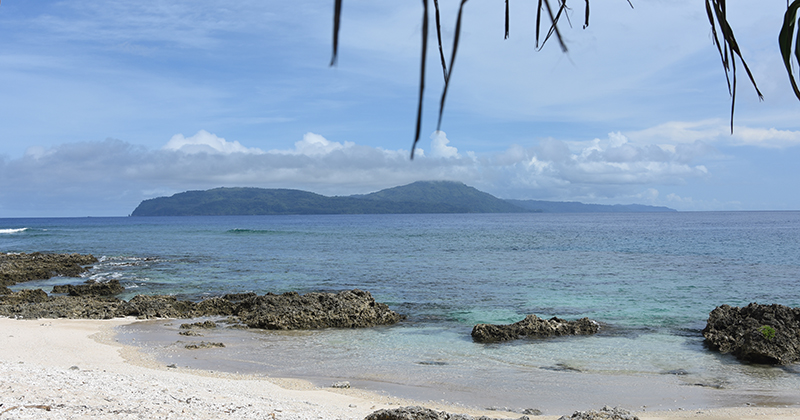
Pentecost from Maewo
Some Ausies in a big Beneteau were anchored here too, They came over for a couple of chats and seemed quite intrigued oh now I managed on my own.

Sunset Asanvari bay
Leaving Asanvani I sailed a little way northwards up the coast of Maewo. This was partly to get a better slant on the wind for crossing to Ambae but also to see some of the waterfalls for which Maewo is renowned and there were lots. It was tempting to go further North but I was aware that time was running out and beside there was a bit of a SW swell which would have made any anchorages up the coast uncomfortable.
Heading over to Ambae I had a very pleasant sail, wind about 12-15 knots on the quarter and light seas. Oh if only all sailing could be that pleasant!
The entrance to Lolowai bay, which is a drowned old volcanic crater, is a little tricky. You have to skirt closely a steep cliff, once a crater wall then cross a coral flat across the remains of part of the crater wall. My depth gauge read 3m and the boat draws 1.5m so not much water under the keel. There are some leading marks to give you the right line but it is worrying stuff all the same. Once in the depth increases and you are in a wonderful calm circular basin protected from most directions. I anchored in about 12 m in black sand and could recover my composure with a welcome cup of tea.
Ashore there was a shop and wonderfully they had bread and some beer, I had been dry for days.
Over the next few days I took some walks, SE along the track towards the airport, W up to a lake over the ridge and S steeply up the back wall of the bay to a ridge and followed to a viewpoint looking far down to the bay.
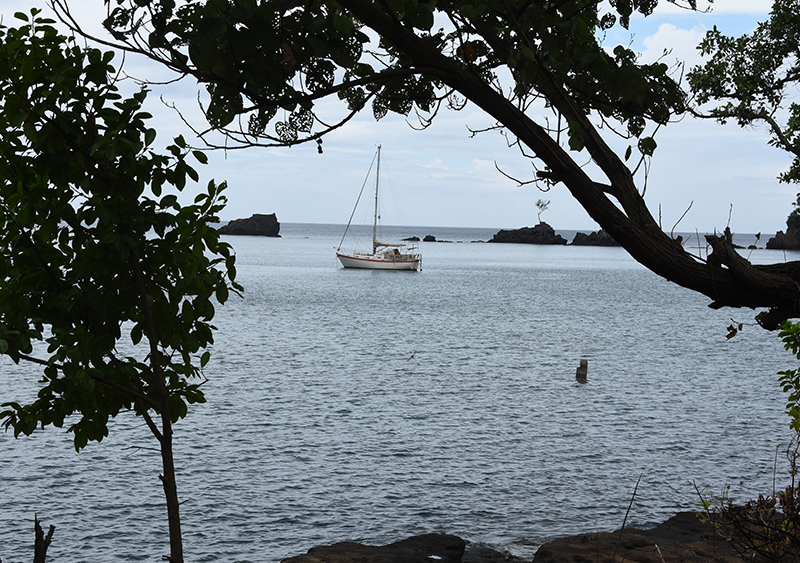

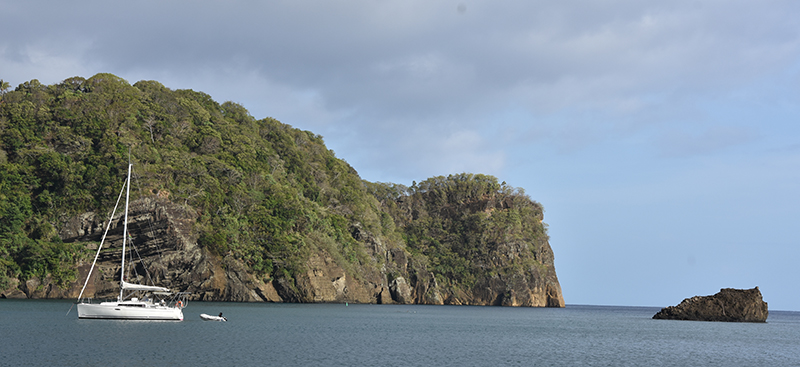
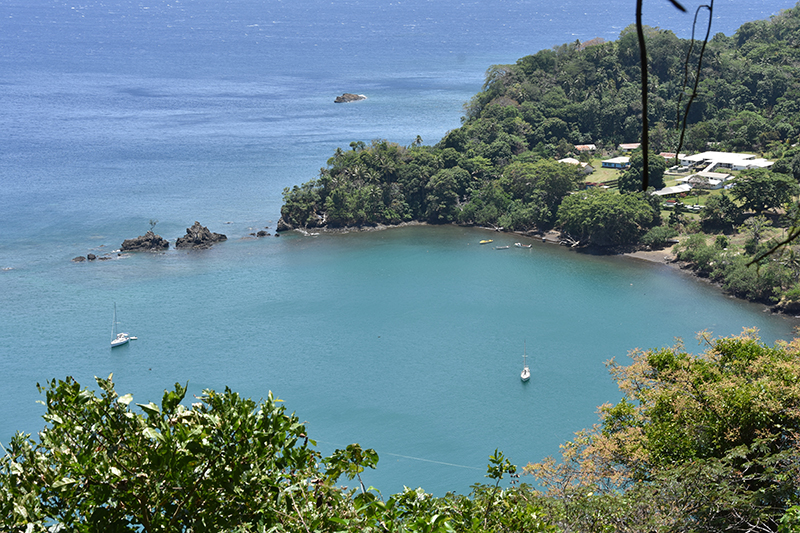
At the boat one afternoon I was visited by a group of swimming children who delighted in climbing aboard (at my invite) and leaping off from the pulpit.
The French couple who I had first meet in Aneityum turned up and anchored in the bay.
I was ready to move on again, a fairly long leg to Espirito Santo for which I would need a very early start. I planned to exit the bay, which you can only do after half tide and anchor just around the corner in Vanihe Bay. All packed up, dinghy stowed and ready late afternoon but a check on the forecast showed a strong wind warning for next day 20-25 knots of wind and rough seas so I put the move off.
Next day was better on around high tide in the late afternoon using the leading marks I motored out over the coral flat and around the cliff headland to anchor off a black sand beach in 7 m. A lovely spot this too, the beach was backed by steep cliffs and there was no access by land so it was unspoilt.

















































